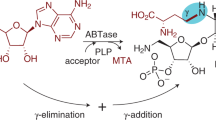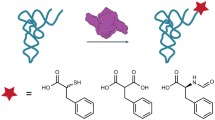Summary
The aminoacylation of diinosine monophosphate (IpI) was studied. When the acylating agent was the imidazolide of N-(tert-butoxycarbonyl)-Dl-alanine, a 40% enantiomeric excess of thel isomer was incorporated at the internal 2′ site and the positions of equilibrium for the 2′⇆3′ migration reaction differed for theD andl enantiomers. The reactivity of the nucleoside hydroxyl groups decreased in the order 2′(3′)>internal 2′>5′, and the extent of reaction was affected by the concentration of the imidazole buffer (pH 7.1). In contrast, reaction of IpI with the imidazolide of unprotectedDl-alanine led to an excess of theD isomer at the internal 2′ site, while reaction with the N-carboxy anhydride ofDl-alanine proceeded without detectable stereoselection. The relevance of these results to the evolution of optical activity and the origin of genetically directed protein synthesis is discussed.
Similar content being viewed by others
Abbreviations
- ImpA:
-
adenosine 5′-phosphorimidazolide
- poly(U):
-
polyuridylic acid
- ApA:
-
adenylyl-(3′–5′)-adenosine
- Boc:
-
N-(tert-butoxycarbonyl)
- poly(A):
-
polyadenylic acid
- poly(C):
-
polycytidylic acid
- poly(G):
-
polyguanylic acid
- Ala-Im:
-
N-(alanyl)imidazole
- CpA:
-
cytidylyl-(3′–5′)-adenosine
- UpC:
-
uridylyl-(3′–5′)-uridine
- IpI:
-
inosinylyl-(3′–5′)-inosine
- Boc-Ala-Im:
-
N-[N-(ter-butoxycarbonyl)alanyl]imidazole
- Boc-Ala:
-
N-(tert-butox-ycarbonyl) alanine
- DMF:
-
N,N-dimethylformamide
- Cbz-Ala:
-
N-(benzyloxycarbonyl)alanine
- UV:
-
ultraviolet
- NMR:
-
nuclear magnetic resonance
- HPLC:
-
high-performance liquid chromatography
- Tris:
-
tris(hydroxymethyl)aminomethane
- EDTA:
-
ethylenediaminetetraacetic acid
- Ino:
-
inosine
- Ip:
-
inosine 3′-phosphate
- I>p:
-
inosine 2′,3′-cyclic phosphate
- 5′-Boc-Ala-2′,3′-O-isopropylidene-Ino:
-
5′-O-[N-(ter-butoxycarbonyl)alanyl]-2′,3′-O-isopropylideneinosine
- 5′-Ala-Ino:
-
5′O(alanyl)inosine
- 2′-Boc-Ala-Ino:
-
2′-O-[N-(tert-butoxycarbonyl)alanyl]inosine
- 3′-Boc-Ala-Ino:
-
3′-O-[N-(tert-butoxycarbonyl)alanyl]inosine
- 5′-Boc-Ala-IpI:
-
5′-O-[N-(tert-butoxycarbonyl)alanyl]inosinylyl-(3′–5′)-inosine
- internal-2′-Boc-Ala-IpI:
-
2′-O-[N-(tert-butoxycarbonyl)alanyl]inosinylyl-(3′–5′)-inosine
- 2′-Boc-Ala-IpI:
-
inosinylyl-(3′–5′)-3′-O[N-(tert-butoxycarbonyl)alanyl]inosine
- 5′-Ala-IpI:
-
5′-O-(alanyl)inosinylyl-(3′–5′)-inosine
- internal-2′-Ala-IpI:
-
2′-O-(alanyl)inosinylyl-(3′–5′)-inosine
- 2′(3′)-Ala-IpI:
-
inosinylyl-(3′–5′)-2′(3′)-O-(alanyl)inosine
References
Ballinger P, Long FA (1960) Acid ionization constants of alcohols II. Acidities of some substituted methanols and related compounds. J Am Chem Soc 82:795–798
Beljanski M, Fischer-Ferraro C, Bourgarel P (1968) Identification des sites d'attachement specifiques d'arginine et de valine dans des RNA d'origines differentes. Eur J Biochem 4:184–189
Ben-Ishai D, Katchalski E (1952) Synthesis of N-carboxy-α-amino acid anhydrides from N-carbalkoxy-α-amino acids by the use of phosphorus tribromide. J Am Chem Soc 74:3688–3689
Blair NE Bonner WA (1980) Experiments on the amplification of optical activity. Orig Life 10:255–263
Blair NE, Bonner WA (1981) A model for the enantiomeric enrichment of polypeptides on the primitive Earth. Orig Life 11:331–335
Blair NE, Dirbas FM, Bonner WA (1981) Stereoselective hydrolysis of leucine oligomers. Tetrahedron 37:27–29
Blaschke G (1980) Chromatographic resolution of racemates. Angew Chem Int Ed Engl 19:13–24
Blout ER, Doty P, Yang JT (1957) Polypeptides. XII. The optical rotation and configurational stability of α-helices. J Am Chem Soc 79:749–750
Bonner WA, Kavasmaneck PR (1976) Asymmetric adsorption ofDl-alanine hydrochloride by quartz. J Org Chem 41:2225–2226
Bonner WA, van Dort MA, Flores JJ (1974) Quantitative gas chromatographic analysis of leucine enantiomers. A comparative study. Anal Chem 46:2104–2111
Bonner WA, Blair NE, Dirbas FM (1981) Experiments on the abiotic amplification of optical activity. Orig Life 11:119–134
Brack A, Spach G (1979) β-structures of polypeptides withl- andd-residues. I. Synthesis and conformational studies. J Mol Evol 13:35–46
Brack A, Spach G (1980) β-Structures of polypeptides withl- andd-residues. III. Experimental evidence for enrichment in enantioner. J Mol Evol 15:231–238
Carter CW, Kraut J (1974) A proposed model for the interaction of polypeptides with RNA. Proc Natl Acad Sci USA 71:283–287
Chinali G, Sprinzl M, Parmeggiani A, Cramer F (1974) Participation in protein biosynthesis of transfer ribonucleic acids bearing altered 3′-terminal ribosyl residues. Biochemistry 13:3001–3010
Doty P, Lundberg RD (1956) Polypeptides. X. Configurational and stereochemical effects in the amine initiated polymerization of N-carboxyanhydrides. J Am Chem Soc 78:4810–4812
Dounce AL (1981) Origin of life — proposed mechanisms for primeval polynucleotide and peptide chain synthesis. J Theor Biol 90:63–79
Eberhardt R, Glotzmann C, Lehner H, Schlogl K (1974) Ermittlung der Enantiomeren Reinheit Chiraler Carbonsauren und Amine Mittels Hochdruck-Flussigkeitschromatographie. Tetrahedron Lett 4365–4368
Feldmann H, Zachau HG (1964) Chemical evidence for the 3′-linkage of amino acids to s-RNA. Biochem Biophys Res Commun 15:13–17
Fraenkel-Conrat H, Steinschneider A (1968) Stepwise degradation of RNA: periodate followed by aniline cleavage. Methods Enzymol 12:243–246
Gil-Av E, Nurok D (1975) Resolution of optical isomers by gas chromatography of diastereomers. Adv Chromatogr 10:99–172
Gottikh BP, Krayevsky AA, Tarussova NB, Purygin PP, Tsilevich TL (1970a) The general synthetic route to amino acid esters of nucleotides and nucleoside-5′-triphosphates and some properties of these compounds. Tetrahedron 26:4419–4433
Gottikh BP, Kraevskii AA, Tsilevich TL, Rudzite LN (1970b) Aminoacyl derivatives of nucleosides, nucleotides, and polynucleotides. Communication 3. Reaction of imidazolide of N-tert-butyloxycarbonyl-glycine with transfer ribonucleic acids. Izv Akad Nauk SSSR [Chem] 113–121 (English 103–110)
Griffin BE, Jarman M, Reese CB, Sulston JE, Trentham DR (1966) Some observations relating to acyl mobility in aminoacyl soluble ribonucleic acids. Biochemistry 5:3638–3649
Harada K (1970) Origin and development of optical activity of organic compounds on the primordial Earth. Naturwissenschaften 57:114–119
Hecht SM (1977) Participation of isomeric tRNA's in the partial reactions of protein biosynthesis. Tetrahedron 33:1671–1696
Henderson JD, Partington CR, Mertes MP (1979) Synthesis and pH effects on the hydrolysis of 5′-adenosyl phenylalanate. J Org Chem 44:1003–1006
Hirschmann R, Strachan RG, Schwam H, Schoenwaldt EF, Joshua H, Barkemeyer B, Verber DF, Palecda WJ, Jacob TA, Beesley TE, Denkewalter RG (1967) The controlled synthesis of peptides in aqueous medium. III. Use of Leuch's anhydrides in the synthesis of dipeptides. Mechanism and control of side reactions. J Org Chem 32:3415–3425
Ikehara M, Honda Y, Ohtsuka E, Imahori K (1977) Polynucleotides. XXXV. Synthesis and properties of a diaminoacyldiribonucleotide; 2′(3′)-phenylalanyl-adenylyl-[3′(2′)-5′]-2′(3′)glycyladenosine. J Carbohydr Nucleosides Nucleotides 4:321–340
Jencks WP, Carriuolo J (1959a) Imidazole catalysis. II. Acyl transfer and the reactions of acetyl imidazole with water and oxygen anions. J Biol Chem 234:1272–1279
Jencks WP, Carriuolo J (1959b) Imidazole catalysis. III. General base catalysis and the reactions of acetyl imidazole with thiols and amines. J Biol Chem 234:1280–1285
Jencks WP, Brant SR, Gandler JR, Fendrich G, Nakamura C (1982) Nonlinear Bronsted correlations: the roles of resonance, solvation, and changing transition-state structure. J Am Chem Soc 104:7045–7051
Kavasmaneck PR, Bonner WA (1977) Adsorption of amino acid derivatives byd-andl-quartz. J Am Chem Soc 99:44–50
Krull IS (1978) The liquid chromatographic resolution of enantiomers. Adv Chromatogr 16:175–210
Lacey JC Jr, Pruitt KM (1969) Origin of the genetic code. Nature 223:799–804
Lacey JC Jr, White WE Jr (1972) Aminoacyl transfer: chemical conversion of an aminoacyl adenylate to an imidazolide. Biochem Biophys Res Commun 47:565–573
Lacey JC Jr, Weber AL, White WE Jr (1975) A model for the coevolution of the genetic code and the process of protein synthesis: review and assessment. Orig Life 6:273–283
Levene PA, Simms HS, Bass LW (1926) The effect of ionization upon optical rotation of nucleic acid derivatives. J Biol Chem 70:243–251
Matsuura K, Inoue S, Tsuruta T (1965) Asymmetric selection in the copolymerization of N-carboxy-l-andd-alanine anhydride. Makromol Chem 85:284–286
McLaughlin CS, Ingram V (1965) Chemical studies on amino acid acceptor ribonucleic acids. V. Position of the amino acid residue in aminoacyl s-RNA: chromatographic approach. Biochemistry 4:1448–1456
Nelsestuen GL (1978) Amino acid-directed nucleic acid synthesis. A possible mechanism in the origin of life. J Mol Evol 11:109–120
Norden B (1978) The asymmetry of life. J Mol Evol 11:313–332
Pirkle WH, House DW (1979) Chiral high-pressure liquid chromatographic stationary phases. I. Separation of the enantiomers of sulfoxides, amines, amino acids, alcohols, hydroxy acids, lactones, and mercaptans. J Org Chem 44:1957–1960
Profy AT, Lo KM, Usher DA (1983) Synthesis of 2′(3′)-O-Dl-analyl hexainosinic acid using T4 RNA ligase: suppression of the enzymic reverse transfer reaction by alkaline phosphatase. Nucleic Acids Res 11:1617–1632
Schimmel PR, Soll D (1979) Aminoacyl-tRNA synthetases: general features and recognition of transfer RNAs. Annu Rev Biochem 48:601–648
Schneider-Bernloehr H, Lohrmann R, Orgel LE, Sulston J, Weimann BJ (1968) Partial resolution ofDl-adenosine by template synthesis. Science 162:809–810
Schuber F, Pinck M (1974) On the chemical reactivity of the aminoacyl-tRNA ester bond. I. Influence of pH and nature of the acyl group on the rate of hydrolysis. Biochimie 56:383–390
Spach G, Brack A (1979) β-Structures of polypeptides withl-andd-residues. II. Statistical analysis and enrichment in enantiomer. J Mol Evol 13:47–56
Sprinzl M, Cramer F (1979) The-C-C-A end of tRNA and its role in protein biosynthesis. Prog Nucleic Acid Res Mol Biol 22:1–69
Taiji M, Yokoyama S, Miyazawa T (1983) Transacylation rates of (aminoacyl)adenosine moiety at the 3′-terminus of aminoacyl transfer ribonucleic acid. Biochemistry 22:3220–3225
Takahashi K, Moore S (1982) Ribonuclease T1. In: Boyer PD (ed) Enzymes, 3rd Ed., vol. 15. Academic Press, New York, p 435
Tarusova NB, Tsilevich TL, Gottikh BP (1975) Aminoacyl derivatives of nucleosides, nucleotides, and polynucleotides. Communication 14. Aminoacylation of oligonucleotides that enter into the composition of the acceptor end of tRNA. Izv Akad Nauk SSSR [Chem] 135–138 (English 124–127)
Tazawa I, Tazawa S, Stempel LM, Ts'o POP (1970)l-Adenylyl-(3′–5′)-l-adenosine andL-adenylyl-(2′–5′)-l-adenosine. Biochemistry, 9:3499–3514
Tazawa S, Tazawa I, Alderfer JL, Ts'o POP (1972) Conformation of oligoninosinates: chain-length dependence and comparison to other oligonucleotides. Biochemistry 11:3544–3558
Thiemann W (1974) The origin of optical activity. Naturwissenschaften 61:476–483
Tsilevich, TL, Tarusova NB, Gottikh BP (1975) Aminoacyl derivatives of nucleosides, nucleotides, and polynucleotides. Communication 15. Aminoacylation of dinucleoside phosphates and dinucleotides. Izv Akad Nauk SSSR [Chem] 916–921 (English 831–835)
Tsuruta T, Inoue S, Matsuura K (1967) Asymmetric selection in the copolymerization of N-carboxy-l- andd-alanine anhydride. Biopolymers 5:313–319
Usher DA (1979) Reverse-phase HPLC of DNA restriction fragments and ribooligonucleotides on uncoated Kel-F powder. Nucleic Acids Res 6:2289–2306
Usher DA (1980) Some constraints on new and old suggestions for the origin of protein synthesis. Tenth Northeast Regional ACS Meeting, abstract 299. American Chemical Society
Usher DA, Richardson DI, Oakenfull DG (1970) Models of ribonuclease action. II. Specific acid, specific base, and neutral pathways for hydrolysis of a nucleotide diester analog. J Am Chem Soc 92:4699–4712
Usher DA, Kole LB, Holy A (1979) Hydrolysis rates of template-bound 2′–5′ and 3′–5′ (l,l)-ApA; the origin of all-(d) nucleosides in contemporary nucleic acids. Symposium at the University of Kent at Canterbury: the mechanisms of reactions in solution, abstract 62
Wald G (1957) The origin of optical activity. Ann NY Acad Sci 69:352–368
Weber AL, Fox SW (1973) Aminoacylation and acetylaminoacylation of homopolyribonucleotides. Biochim Biophys Acta 319:174–187
Weber AL, Lacey JC Jr (1975) Aminoacyl transfer from an adenylate anhydride to polyribonucleotides. J Mol Evol 6:309–320
Weber AL, Orgel LE (1980) Poly(U)-directed peptide-bond formation from the 2′(3′)-glycyl esters of adenosine derivatives. J Mol Evol 16:1–10
White DH, Erickson JC (1981) Enhancement of peptide bond formation by polyribonucleotides on clay surfaces in fluctuating environments. J Mol Evol 17:19–26
White WE Jr, Lacey JC Jr, Weber AL (1973) Aminoacyl transfer from adenylate anhydride to the 2′-OH groups along the backbone of polyribonucleotides. Biochem Biophys Res Commun 51:283–291
Wolfenden R (1963) The mechanism of hydrolysis of aminoacyl RNA. Biochemistry 2:1090–1092
Zachau HG, Feldmann H (1965) Amino acid esters of RNA, nucleotides, and related compounds. Prog Nucleic Acid Res Mol Biol 4:217–230
Author information
Authors and Affiliations
Rights and permissions
About this article
Cite this article
Profy, A.T., Usher, D.A. Stereoselective aminoacylation of a dinucleoside monophosphate by the imidazolides ofDl-alanine and N-(tert-butoxycarbonyl)-Dl-alanine. J Mol Evol 20, 147–156 (1984). https://doi.org/10.1007/BF02257375
Received:
Revised:
Issue Date:
DOI: https://doi.org/10.1007/BF02257375




